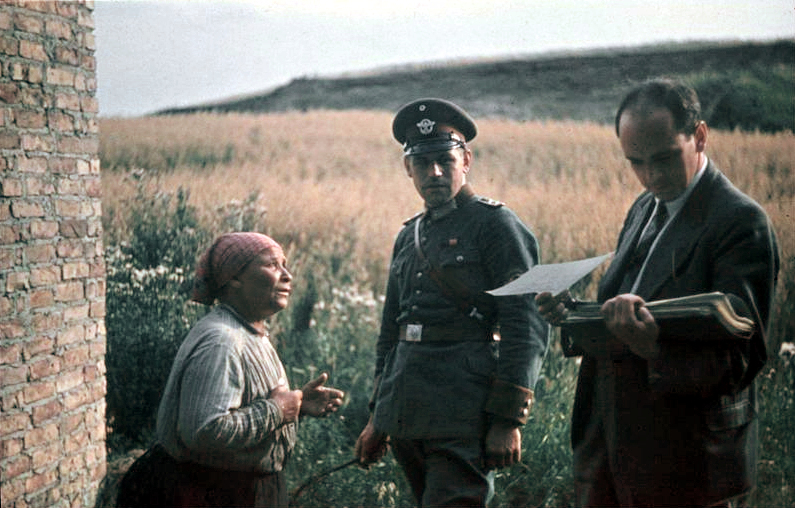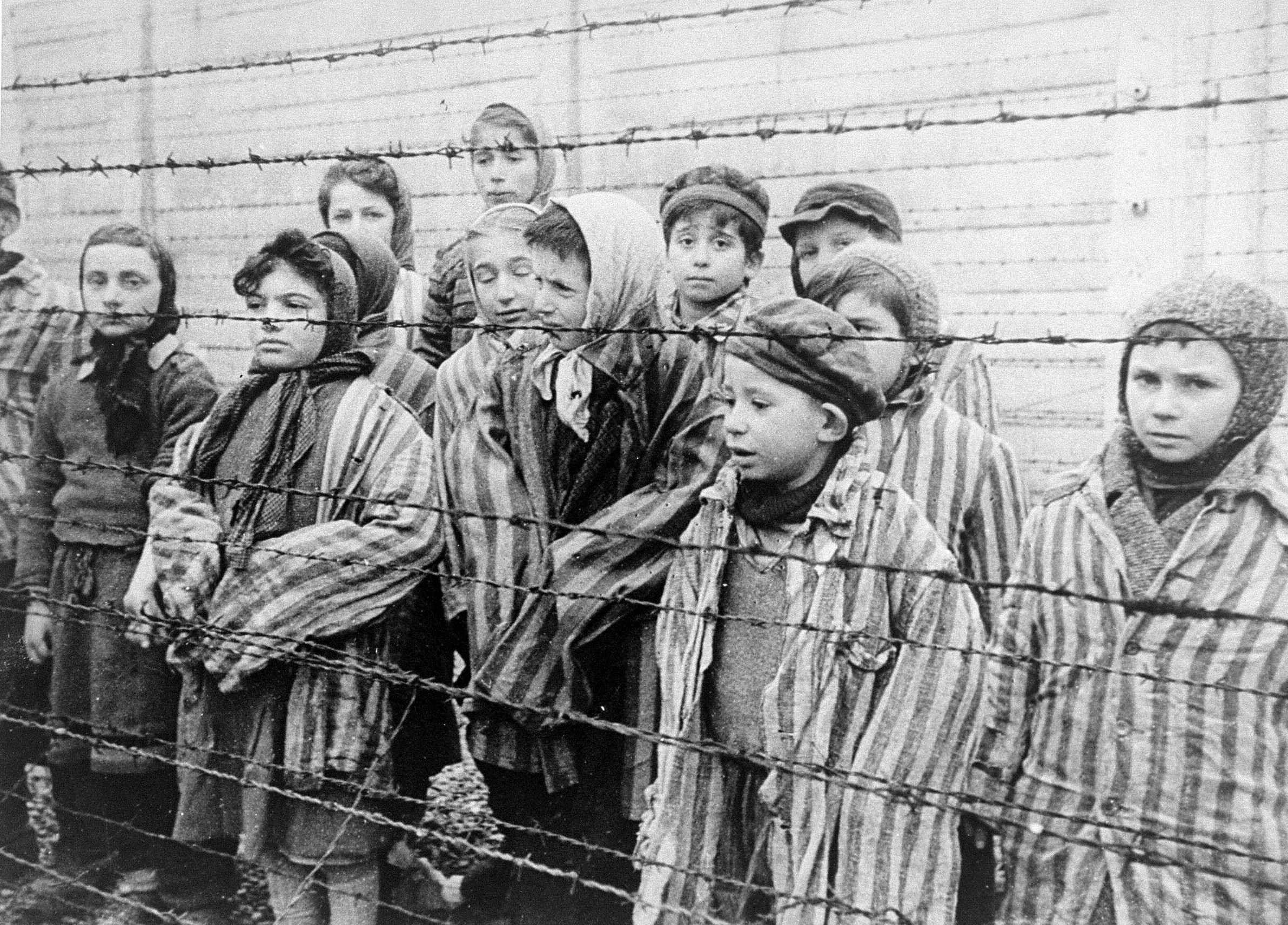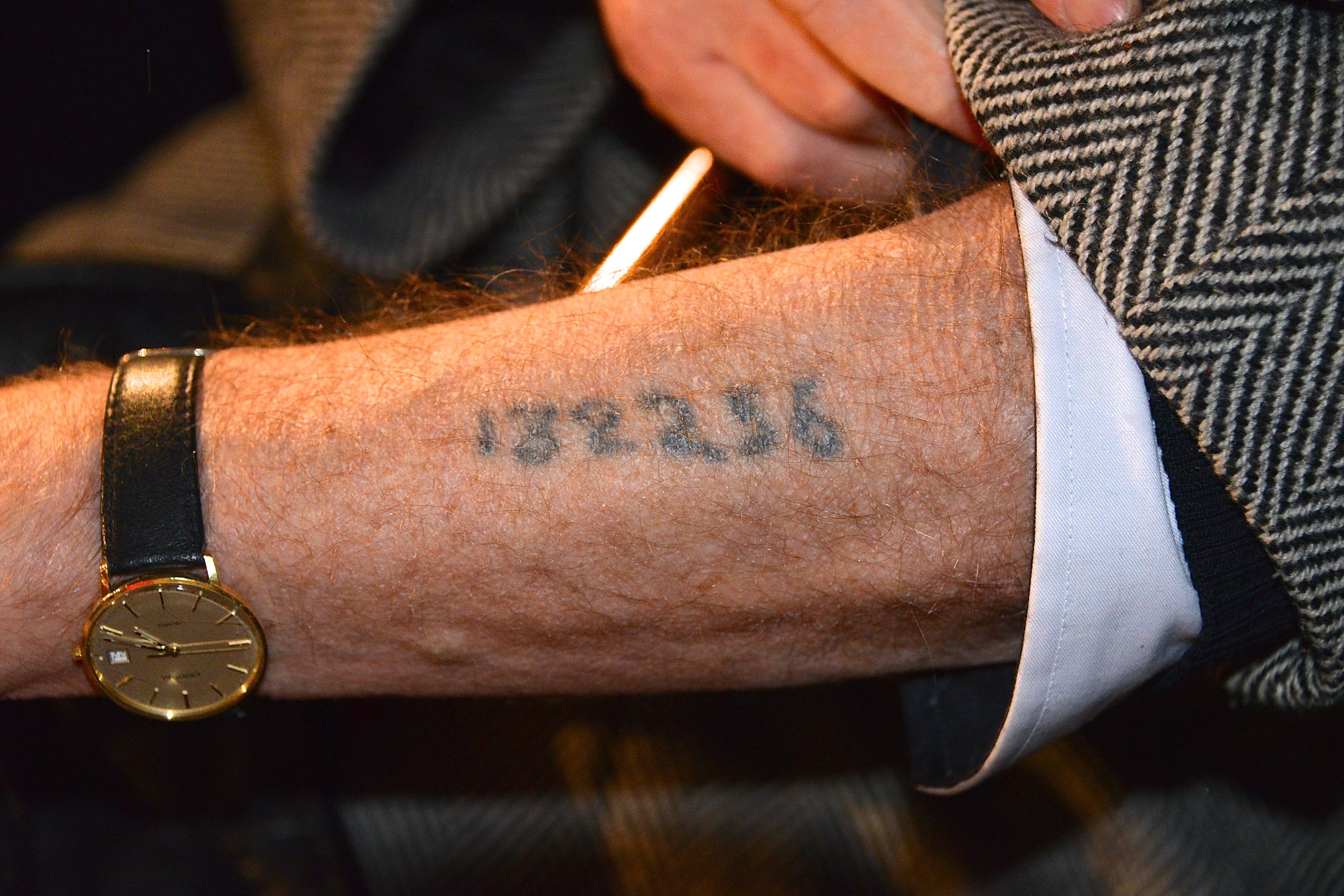|
Margarethe Kraus
Margarete Kraus (born 1928) was a Roma woman who was persecuted during the Porajmos, imprisoned at Auschwitz and Ravensbruck. Her experience was recorded in later life by the photographer Reimar Gilsenbach. Biography Whilst little is known about Kraus' early life, what is known is that she was a young woman of Roma origin, who was living in Czechoslovakia with her family prior to their deportation to Auschwitz in 1943. Roma and Sinti people were persecuted during the Holocaust and Kraus family were part of the 500,000 who were murdered in the Romani genocide. Kraus was deported to Auschwitz in 1943, aged 13, alongside her family; they were held in what became known as the Gypsy family camp. She was subjected to medical experimentation during her internment. She suffered extreme abuse and deprivation, and also contracted typhus. Her parents were murdered in Auschwitz, and she was subsequently moved to Ravensbruck where she was used as forced labour. In 1966 Kraus was photog ... [...More Info...] [...Related Items...] OR: [Wikipedia] [Google] [Baidu] |
Roma Holocaust
The Romani Holocaust or the Romani genocide—also known as the ''Porajmos'' (Romani pronunciation: , meaning "the Devouring"), the ''Pharrajimos'' meaning the hard times ("Cutting up", "Fragmentation", "Destruction"), and the ''Samudaripen'' ("Mass killing")—was the effort by Nazi Germany and its World War II allies to commit ethnic cleansing and eventually genocide against Europe's Romani people (including the Sinti) during the Holocaust era. Under Adolf Hitler, a supplementary decree to the Nuremberg Laws was issued on 26 November 1935, classifying the Romani as "enemies of the race-based state", thereby placing them in the same category as the Jews. Thus, the fate of the Roma in Europe paralleled that of the Jews in the Holocaust. Historians estimate that between 250,000 and 500,000 Romani and Sinti were killed by Germans and their collaborators—25% to over 50% of the estimate of slightly fewer than 1 million Roma in Europe at the time. Later research cited by Ian Hanc ... [...More Info...] [...Related Items...] OR: [Wikipedia] [Google] [Baidu] |
Auschwitz Concentration Camp Prisoners
Auschwitz concentration camp ( (); also or ) was a complex of over 40 concentration and extermination camps operated by Nazi Germany in occupied Poland (in a portion annexed into Germany in 1939) during World War II and the Holocaust. It consisted of Auschwitz I, the main camp (''Stammlager'') in Oświęcim; Auschwitz II-Birkenau, a concentration and extermination camp with gas chambers; Auschwitz III-Monowitz, a labor camp for the chemical conglomerate IG Farben; and dozens of subcamps. The camps became a major site of the Nazis' final solution to the Jewish question. After Germany sparked World War II by invading Poland in September 1939, the ''Schutzstaffel'' (SS) converted Auschwitz I, an army barracks, into a prisoner-of-war camp. The initial transport of political detainees to Auschwitz consisted almost solely of Poles for whom the camp was initially established. The bulk of inmates were Polish for the first two years. In May 1940, German criminals brought to ... [...More Info...] [...Related Items...] OR: [Wikipedia] [Google] [Baidu] |
Holocaust Survivors
Holocaust survivors are people who survived the Holocaust, defined as the persecution and attempted annihilation of the Jews by Nazi Germany and Axis powers, its allies before and during World War II in Europe and North Africa. There is no universally accepted definition of the term, and it has been applied variously to Jews who survived the war in German-occupied Europe or other Axis territories, as well as to those who fled to Allies (World War II), Allied and Neutral powers during World War II, neutral countries before or during the war. In some cases, non-Jews who also experienced collective persecution under the Nazi regime are also considered Holocaust survivors. The definition has evolved over time. Survivors of the Holocaust include those persecuted civilians who were still alive in the Nazi concentration camps, concentration camps when they were liberated at the end of the war, or those who had either Jewish partisans, survived as partisans or been hidden with the Righte ... [...More Info...] [...Related Items...] OR: [Wikipedia] [Google] [Baidu] |
1928 Births
Nineteen or 19 may refer to: * 19 (number), the natural number following 18 and preceding 20 * one of the years 19 BC, AD 19, 1919, 2019 Films * ''19'' (film), a 2001 Japanese film * ''Nineteen'' (film), a 1987 science fiction film Music * 19 (band), a Japanese pop music duo Albums * ''19'' (Adele album), 2008 * ''19'', a 2003 album by Alsou * ''19'', a 2006 album by Evan Yo * ''19'', a 2018 album by MHD * ''19'', one half of the double album ''63/19'' by Kool A.D. * ''Number Nineteen'', a 1971 album by American jazz pianist Mal Waldron * ''XIX'' (EP), a 2019 EP by 1the9 Songs * "19" (song), a 1985 song by British musician Paul Hardcastle. * "Nineteen", a song by Bad4Good from the 1992 album '' Refugee'' * "Nineteen", a song by Karma to Burn from the 2001 album ''Almost Heathen''. * "Nineteen" (song), a 2007 song by American singer Billy Ray Cyrus. * "Nineteen", a song by Tegan and Sara from the 2007 album '' The Con''. * "XIX" (song), a 2014 song by Slipk ... [...More Info...] [...Related Items...] OR: [Wikipedia] [Google] [Baidu] |
2005 Deaths
This is a list of deaths of notable people, organised by year. New deaths articles are added to their respective month (e.g., Deaths in ) and then linked here. 2022 2021 2020 2019 2018 2017 2016 2015 2014 2013 2012 2011 2010 2009 2008 2007 2006 2005 2004 2003 2002 2001 2000 1999 1998 1997 1996 1995 1994 1993 1992 1991 1990 1989 1988 1987 See also * Lists of deaths by day The following pages, corresponding to the Gregorian calendar, list the historical events, births, deaths, and holidays and observances of the specified day of the year: Footnotes See also * Leap year * List of calendars * List of non-standard ... * Deaths by year {{DEFAULTSORT:deaths by year ... [...More Info...] [...Related Items...] OR: [Wikipedia] [Google] [Baidu] |
Wiener Library For The Study Of The Holocaust And Genocide
The Wiener Holocaust Library () is the world's oldest institution devoted to the study of the Holocaust, its causes and legacies. Founded in 1933 as an information bureau that informed Jewish communities and governments worldwide about the persecution of the Jews under the Nazis, it was transformed into a research institute and public access library after the end of World War II and is situated in Russell Square, London. In 2017, and following a campaign by Dan Plesch, (director of the Centre for International Studies and Diplomacy at SOAS University of London) and other researchers, directed at the UN, the library published an online and searchable version of the catalogue of the archive of the UN War Crimes Commission. It is also home to the UK's digital copy of the International Tracing Service archive, the physical copy of which is held in the Arolsen Archives – International Center on Nazi Persecution in Bad Arolsen, Germany. History Alfred Wiener, a German Jew who ... [...More Info...] [...Related Items...] OR: [Wikipedia] [Google] [Baidu] |
Identification Of Inmates In German Concentration Camps
Identification of inmates in German concentration camps was performed mostly with identification numbers marked on clothing, or later, tattooed on the skin. More specialized identification in Nazi concentration camps was done with badges on clothing and armbands. Numbers A practice was established to tattoo the inmates with identification numbers. Prisoners sent straight to gas chambers didn't receive anything. Initially, in Auschwitz, the camp numbers were sewn on the clothes; with the increased death rate, it became difficult to identify corpses, since clothes were removed from corpses. Therefore, the medical personnel started to write the numbers on the corpses' chests with indelible ink. Difficulties increased in 1941 when Soviet prisoners of war came in masses, and the first few thousand tattoos were applied to them. This was done with a special stamp with the numbers to be tattooed composed of needles. The tattoo was applied to the upper left part of the breast. In March 19 ... [...More Info...] [...Related Items...] OR: [Wikipedia] [Google] [Baidu] |
The Jewish Chronicle
''The'' () is a grammatical Article (grammar), article in English language, English, denoting persons or things already mentioned, under discussion, implied or otherwise presumed familiar to listeners, readers, or speakers. It is the definite article in English. ''The'' is the Most common words in English, most frequently used word in the English language; studies and analyses of texts have found it to account for seven percent of all printed English-language words. It is derived from gendered articles in Old English which combined in Middle English and now has a single form used with pronouns of any gender. The word can be used with both singular and plural nouns, and with a noun that starts with any letter. This is different from many other languages, which have different forms of the definite article for different genders or numbers. Pronunciation In most dialects, "the" is pronounced as (with the voiced dental fricative followed by a schwa) when followed by a consonant s ... [...More Info...] [...Related Items...] OR: [Wikipedia] [Google] [Baidu] |
Romani People
The Romani (also spelled Romany or Rromani , ), colloquially known as the Roma, are an Indo-Aryan ethnic group, traditionally nomadic itinerants. They live in Europe and Anatolia, and have diaspora populations located worldwide, with significant concentrations in the Americas. In the English language, the Romani people are widely known by the exonym Gypsies (or Gipsies), which is considered pejorative by many Romani people due to its connotations of illegality and irregularity as well as its historical use as a racial slur. For versions (some of which are cognates) of the word in many other languages (e.g., , , it, zingaro, , and ) this perception is either very small or non-existent. At the first World Romani Congress in 1971, its attendees unanimously voted to reject the use of all exonyms for the Romani people, including ''Gypsy'', due to their aforementioned negative and stereotypical connotations. Linguistic and genetic evidence suggests that the Roma originated ... [...More Info...] [...Related Items...] OR: [Wikipedia] [Google] [Baidu] |
Gypsy Family Camp (Auschwitz)
The Gypsy family camp (german: Zigeunerfamilienlager) was Section B-IIe of the Auschwitz II-Birkenau concentration camp, where Romani families deported to the camp were held together, instead of being separated as was typical at Auschwitz. History On 10 December 1942, Heinrich Himmler issued an order to send all Romani (german: Zigeuner, "Gypsies") to concentration camps, including Auschwitz. A separate camp was set up at Auschwitz II-Birkenau, classed as Section B-IIe and known as the ("Gypsy family camp"). The first transport of German Roma arrived on 26 February 1943, and was housed in Section B-IIe. Approximately 23,000 Roma had been brought to Auschwitz by 1944, of whom 20,000 died there. One transport of 1,700 Polish Sinti and Roma were killed in the gas chambers upon arrival, as they were suspected to be ill with spotted fever. Roma and Sinti prisoners were used primarily for construction work. Thousands died of typhus and noma due to overcrowding, poor sanitary condition ... [...More Info...] [...Related Items...] OR: [Wikipedia] [Google] [Baidu] |
Romani Genocide
The Romani Holocaust or the Romani genocide—also known as the ''Porajmos'' (Romani pronunciation: , meaning "the Devouring"), the ''Pharrajimos'' meaning the hard times ("Cutting up", "Fragmentation", "Destruction"), and the ''Samudaripen'' ("Mass killing")—was the effort by Nazi Germany and its World War II allies to commit ethnic cleansing and eventually genocide against Europe's Romani people (including the Sinti) during the Holocaust era. Under Adolf Hitler, a supplementary decree to the Nuremberg Laws was issued on 26 November 1935, classifying the Romani as "enemies of the race-based state", thereby placing them in the same category as the Jews. Thus, the fate of the Roma in Europe paralleled that of the Jews in the Holocaust. Historians estimate that between 250,000 and 500,000 Romani and Sinti were killed by Germans and their collaborators—25% to over 50% of the estimate of slightly fewer than 1 million Roma in Europe at the time. Later research cited by Ian Hanc ... [...More Info...] [...Related Items...] OR: [Wikipedia] [Google] [Baidu] |





.png)
